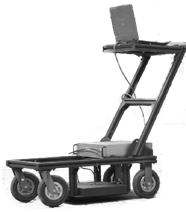Ground Penetrating Radar (GPR) for landmine detection
Prof. Shalabh Gupta & Prof. Joseph John
A GPR sends radio waves into the ground, and the reflected signal is analyzed to detect and characterize subsurface anomalies. The penetration depth depends on the frequency of operation and soil conditions. In ideal conditions, the GPR developed in the project can detect anomalies up to 10m in depth. This GPR can be carried in a small vehicle and the development of a handheld version of it is in progress.
The Ground Penetrating Radar is used for imaging structures and objects lying below the earth’s surface. To achieve this goal, electromagnetic (EM) radiations are transmitted into the ground. Due to variations in the dielectric constants of various structural features or due to the changes in contents of soil, the propagating EM waves experience impedance variations and discontinuities. Due to these variations and discontinuities, the transmitted EM waves are partially scattered back and are captured by the receiver. Signal processing in receiver electronics is used for comparing the transmitted and the received pulses to provide information about the underlying structures/objects, such as the presence of the object, its shape, size and/or its location (in the 3D space).

In this project, a radar architecture with ultra-wide-bandwidth (UWB) is used for simplicity. Our system has been tested for free space as well as sub-surface target detection. The GPR can be used to detect concealed underground objects such as IEDs and sub-surface anomalies such as tunnels.
